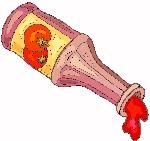Origin
Claim: HIV+ blood has been slipped into ketchup dispensers in fast food restaurants.
Status: False.
Example: [Collected on the Internet, 2004]
Scary Please Read!!!!!!!!!!!!!! SEND THIS TO AS MANY PEOPLE AS POSSIBLE. PEOPLE ARE SICK. This is something you may want to take note of: ONLY USE KETCHUP FROM THE PACKET IN FAST FOOD OUTLETS!! A man was caught placing blood in the ketchup dispenser at a fast food outlet (to remain unnamed) within the last month. It is believed that he is HIV+. So be sure to let your friends/family know...only use items that come in a closed packet.
|
Origins: This helpful heads-up about restaurant condiments began appearing in our inbox in early October 2004.

Although the account lacks specifics which could be researched and disproved (the perpetrator was identified solely as "a man," the eatery where the adulterated ketchup dispenser was discovered was "a fast food outlet (to remain unnamed)," and the incident happened "within the last month"), it should nonetheless be dismissed as poppycock.
We have failed to find any news accounts about such a tampering, in the U.S. or elsewhere. Had such an incident occurred, it would have been picked up by at least a few news outlets.
The Centers for Disease Control emphatically says people cannot acquire HIV via restaurant food:
No incident of food being contaminated with HIV-infected blood or semen has been reported to CDC. Furthermore, CDC has received no reports of HIV infection resulting from eating food, including condiments.
HIV does not live long outside the body. Even if small amounts of HIV-infected blood or semen was consumed, exposure to the air, heat from cooking, and stomach acid would destroy the virus. Therefore, there is no risk of contracting HIV from eating food.
Since its 2004 origin, the hoax has continued to circulate in e-mail, even on some occasions being forwarded by senders one would assume were credible. In 2006, a staff member of the Alabama Attorney General's office forwarded it to her acquaintances. The inclusion of her signature, which identified her as being with that office, added credence to the false tale.
In 2007, an employee with the Department of Health and Human Services in Arkansas causes similar concern by forwarding the e-mail from her work account, a process that appended the name, phone number, fax number, and e-mail address of that agency to the
hoax.
As for the potential for harm were someone to attempt such a contamination, it's non-existent. The HIV virus does not long survive outside its host medium of human bodily fluids: blood, semen, vaginal fluid, breast milk, saliva, tears. (Which is not to say HIV can be transmitted by every one of those — according to the Centers for Disease Control (aka the CDC), "Contact with saliva, tears, or sweat has never been shown to result in transmission of HIV.") The CDC says except under laboratory conditions, HIV is unable to reproduce outside its living host — it therefore, does not spread or maintain infectiousness outside its host. Therefore, were HIV-tainted blood to be mixed into a condiments vat, the virus would neither survive nor while it was still viable multiply and so replenish itself.
While it is tempting to rule out the adulterated ketchup tale on the basis of folks' failure to acquire the virus through oral contact with or swallowing of HIV-laden bodily fluids, the CDC confirms there have been infections through oral transmission. Though infection by this route is far less likely, it does happen. However, whatever oral transmission infections there have been, none have so far come from contact with or ingestion of a food product or beverage — all have been through sexual contact.
The folkloric element of blood being secreted in brownish or reddish foodstuffs is common to other legends, including the belief that rather than discard bloody cows' milk dairies use it in chocolate milk and that the popular beverage Jägermeister contains deer or elk blood.
The urban legend canon is rife with tales about innocent parties catching AIDS through casual and unsuspecting contact with harmless items or through the conduct of uninjurious activities (HIV-laden needles affixed to gas pump handles, or left in the coin returns of payphones, or used to booby-trap seats in movie theatres, or HIV-infected semen secreted in pizza or other fast foods, for example). Such lore's popularity grows out of our fear of contracting the AIDS virus. Even if we take pains to avoid engaging in high risk activities or strive to do so in as safe a fashion as possible, we're all too aware we're still vulnerable, and these legends speak to that awareness. Though in the early days of this disease, the average citizen felt perfectly safe from its ravages, AIDS is no longer perceived as something that only other people will catch. It's now seen as a danger to all of us.
This sense of being at risk, coupled with ongoing fears of the madmen who walk among us, has given birth to this form of scarelore. Today it's ketchup; tomorrow it will be something else.
Barbara "devil take the Heinzmost" Mikkelson
Last updated: 15 July 2011
 Sources:
Sources:- Lyon, John. "HIV Ketchup E-Mail A Hoax, Officials Say."
- [Fort Smith, AR] Times Record. 27 April 2007.
- Miller, Stephanie. "'Blood in the Ketchup' Email a Hoax, According to Officials."
- The [Dublin] Courier Herald. 13 December 2004.
